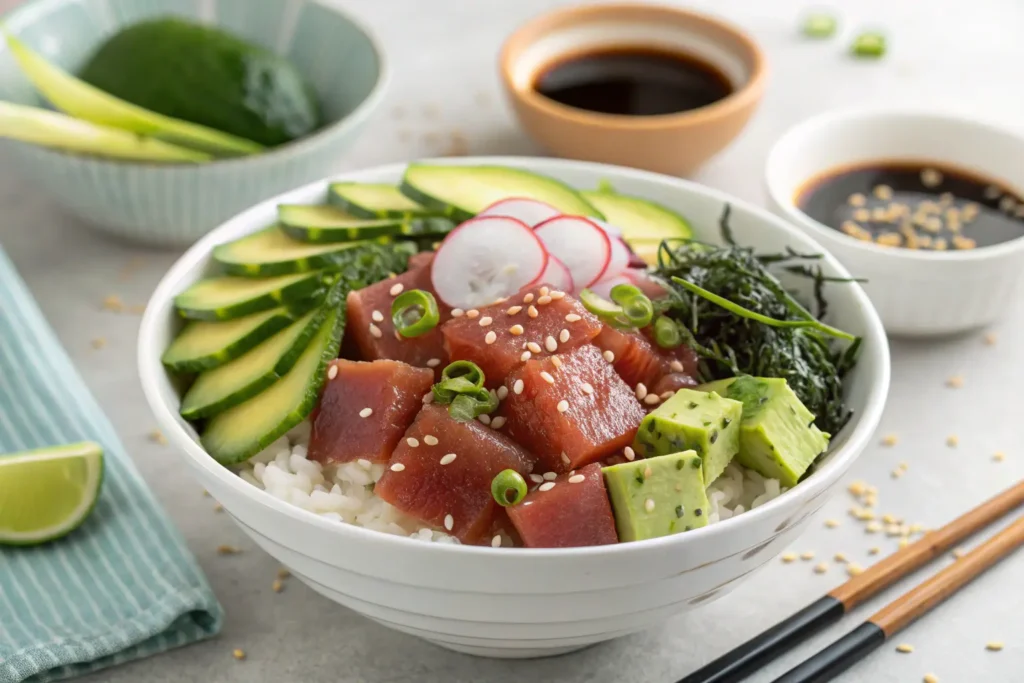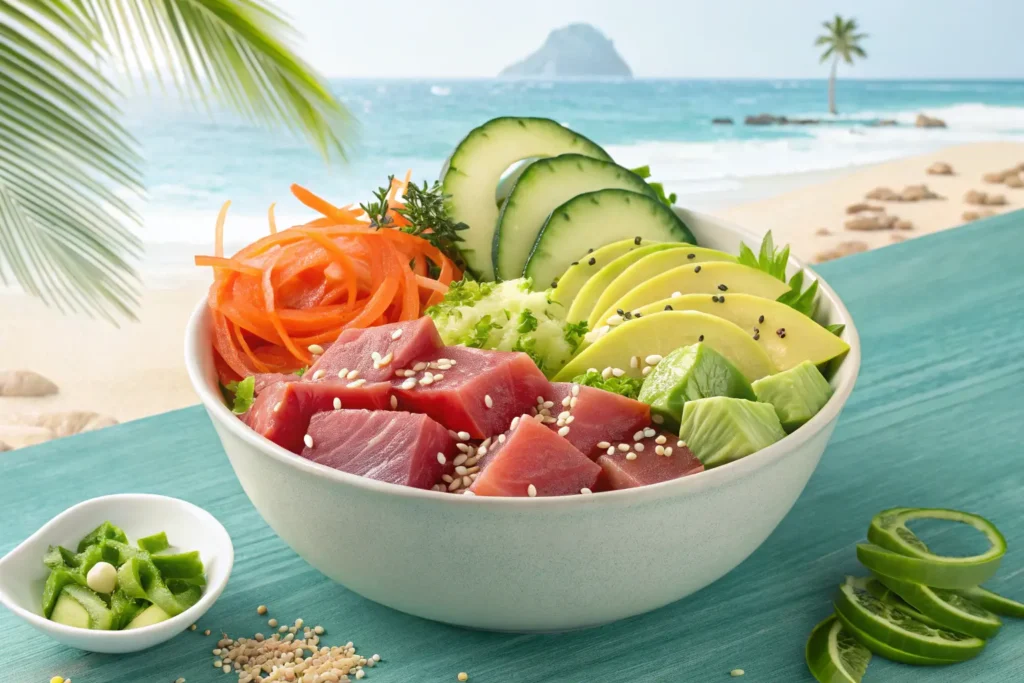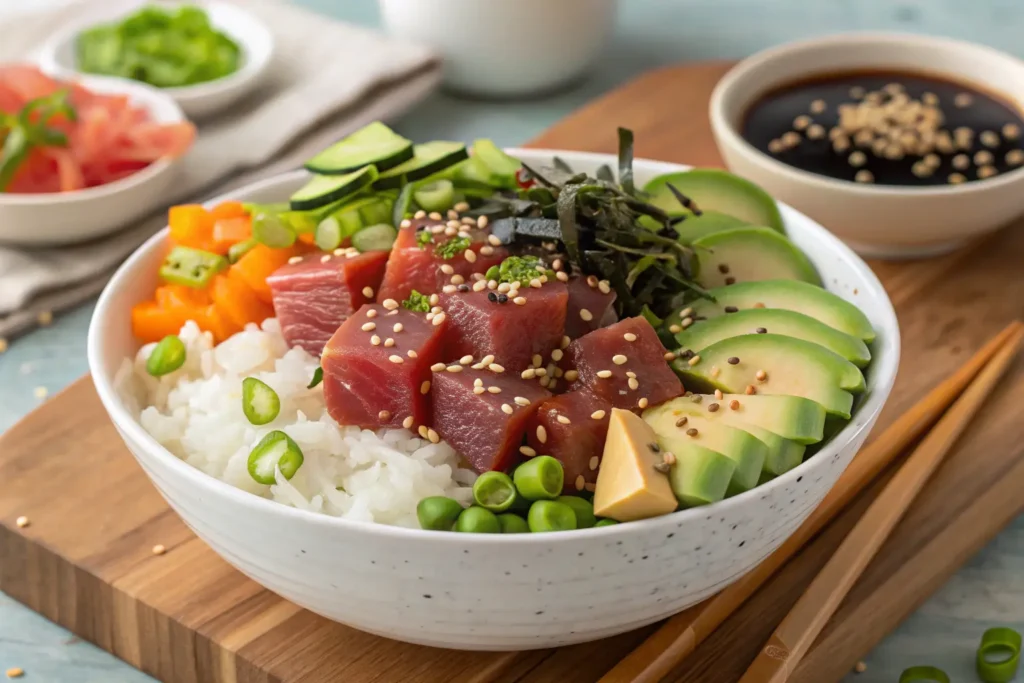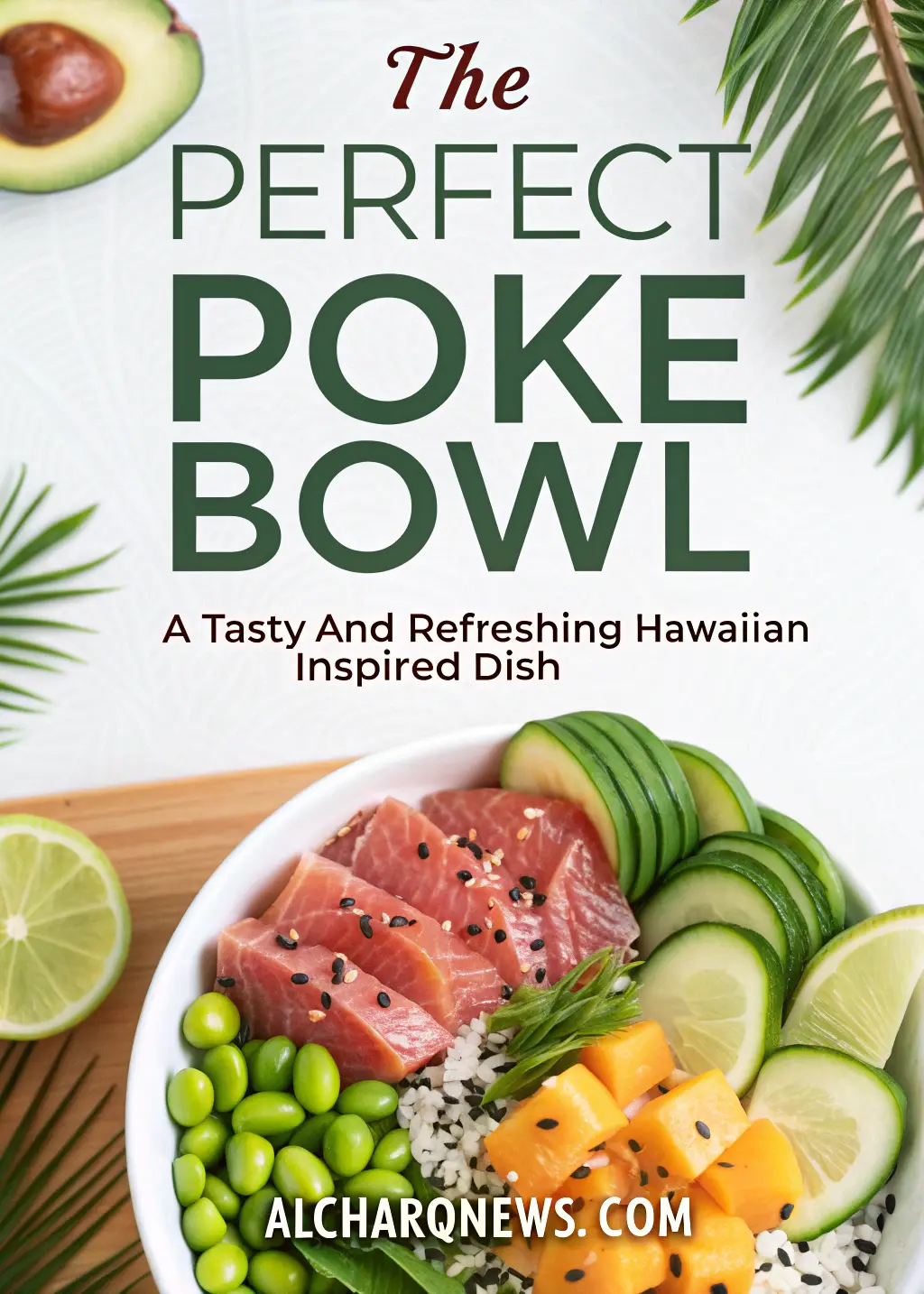Finding Paradise in a Poke Bowl
Standing on the North Shore of Oahu, with salty Pacific breezes ruffling my shirt and volcanic mountains framing the horizon, I experienced my first authentic poke bowl. That initial taste—cubes of ruby-red ahi tuna glistening with sesame oil, nestled against warm rice and crisp vegetables—wasn’t merely delicious; it formed an instant connection to Hawaiian culture that transcended simple nourishment.
Years later, thousands of miles from those sun-drenched shores, recreating that perfect poke bowl transports me back to island time with every bite. This Hawaiian-inspired dish offers more than flavor—it provides a sensory gateway to paradise, regardless of your location or current weather forecast.
Throughout your culinary adventures, few dishes match the refreshing simplicity and nourishing satisfaction of a thoughtfully crafted poke bowl. The beauty lies not just in its vibrant appearance, but in how thoroughly this dish celebrates fresh ingredients with minimal processing. When summer temperatures climb or winter blues demand tropical escape, your perfect poke bowl awaits.
Table of contents

What Makes a Poke Bowl Special: Origins and Evolution
The Hawaiian Roots of Poke
Long before mainland food trends discovered poke bowls, native Hawaiian fishermen sustained themselves with simple preparations of their daily catch. The word “poke” (pronounced poh-kay) literally means “to slice or cut” in Hawaiian, reflecting the dish’s preparation method—fresh fish cut into bite-sized pieces.
Traditional poke consisted of just a handful of ingredients: freshly caught fish, Hawaiian sea salt (‘alaea), seaweed (limu), and sometimes crushed roasted candlenuts (inamona). This humble beginning established poke as practical sustenance rather than culinary showpiece. At community gatherings and family meals, poke connected Hawaiians to their ocean environment, honoring both sustainability and flavor through thoughtful simplicity.
The Modern Poke Bowl Revolution
The journey from traditional Hawaiian preparation to international food phenomenon began in the early 2000s, gaining serious momentum around 2012 when mainland chefs recognized poke’s potential. The genius adaptation that sparked global popularity? Transforming poke into a customizable bowl format—combining marinated fish with various bases, toppings, and sauces.
Contemporary poke bowls reflect influences beyond Hawaiian shores, particularly drawing from Japanese, Korean, and broader Asian flavor profiles. This culinary evolution parallels modern diners’ desires for personalized, nutritious, yet exciting food experiences. Market researchers now project the global poke market to exceed $2.5 billion by 2027, confirming this dish has evolved far beyond fleeting trend status.
When you enjoy a poke bowl today, you’re participating in this remarkable culinary evolution—a dish that honors traditional Hawaiian flavors while embracing global influences and contemporary nutritional priorities.
Essential Components of the Perfect Poke Bowl
The Foundation: Rice and Alternatives
The foundation of your perfect poke bowl deserves careful consideration—it comprises nearly half your dish and significantly impacts both texture and flavor. Traditional white sushi rice offers a neutral canvas that complements fish beautifully, particularly when seasoned with rice vinegar, a touch of sugar, and salt.
For additional nutritional benefits, consider short-grain brown rice, which introduces nutty flavors and extra fiber. Modern interpretations venture further with quinoa (adding protein boost), cauliflower rice (reducing carbohydrates), or mixed greens (creating a lighter profile).
The temperature of your base matters tremendously. Slightly warm rice creates pleasant temperature contrast against cool fish, while room-temperature grains prevent moisture leaching from your carefully prepared toppings. Whatever foundation you select, prepare it with intention—your perfect poke bowl demands nothing less.
The Star Attraction: Selecting and Preparing Protein
Fish and Seafood Options
| Protein | Best Qualities for Poke | Preparation Notes | Sustainability Considerations |
|---|---|---|---|
| Ahi Tuna (Yellowfin) | Firm texture, clean ocean flavor | Flash-frozen for safety | Choose pole-caught, MSC-certified sources |
| Salmon | Buttery mouthfeel, rich flavor | Higher fat content than tuna | Look for BAP or ASC certification |
| Hamachi (Yellowtail) | Delicate sweetness, premium option | Requires impeccable freshness | Responsibly farmed varieties recommended |
| Octopus (Tako) | Authentic choice, distinctive chew | Pre-cook gently for tenderness | Among most sustainable seafood choices |
| Shrimp | Accessible option, familiar flavor | Quick-poach and chill thoroughly | North American sources minimize impact |
| Scallops | Natural sweetness, delicate texture | Brief sear optional for caramelization | Select dry (day boat) scallops when possible |
When selecting fish for your poke bowl, freshness rules absolutely. Seek out markets specializing in sushi-grade offerings (technically meaning “previously frozen at temperatures that kill parasites”). The visual markers of quality remain consistent: fish should appear vibrantly colored, smell faintly of ocean rather than “fishy,” and feel firm when gently pressed.
For cutting, aim for consistent 1/2-inch cubes—large enough to showcase texture but small enough to marry with other ingredients. Pat fish thoroughly dry before cutting, using a paper towel to remove excess moisture. This seemingly minor step dramatically improves texture and marinade absorption.
Plant-Based Protein Alternatives
Plant-based eaters needn’t miss poke’s pleasures. Extra-firm tofu, pressed thoroughly and marinated aggressively, provides satisfying texture. For dramatic visual impact, watermelon “tuna” delivers impressive results—simply remove rind, cut into cubes, marinate in soy sauce and rice vinegar, then gently compress to concentrate flavor and create firmer texture.
Meaty mushroom varieties like king oyster or trumpet mushrooms offer umami-rich alternatives when sliced, briefly seared, and marinated. Even ripe avocado can serve as protein complement, bringing creamy richness to your bowl.

Flavor Foundations: Creating the Perfect Marinade
The marinade transformation elevates raw ingredients into crave-worthy poke. Traditional Hawaiian preparations combine soy sauce, sesame oil, and perhaps green onions with remarkable restraint. This approach showcases fish quality rather than masking it beneath aggressive flavors.
Contemporary marinades branch into diverse territory: spicy versions featuring sriracha or gochujang; citrus-forward profiles highlighting ponzu or fresh lime; and creamy variations incorporating aioli or spicy mayo. Whatever direction inspires you, remember marinade timing matters critically—15 to 30 minutes suffices for most fish, while delicate varieties like salmon need even less to prevent unwanted “cooking” from acidic ingredients.
For marinade success, balance four essential flavor components: salt (soy sauce), fat (sesame oil), acid (citrus or vinegar), and umami (fish sauce, seaweed, or mushroom elements). This harmonious combination creates depth that distinguishes memorable poke from merely adequate versions.
Fresh Additions: Vegetables, Fruits and Toppings
The vibrant color palette and textural contrast in your perfect poke bowl comes from thoughtfully selected fresh ingredients. Persian cucumbers, sliced on bias for maximum surface area, provide essential crunch. Ripe avocado introduces creamy counterpoint to firm fish. Edamame contributes subtle vegetal notes alongside complete protein. Colorful radish varieties—watermelon, daikon, or easter egg—deliver peppy crunch and visual appeal.
Fruit accents transform good poke into remarkable experiences: mango cubes balance savory elements with tropical sweetness; pineapple chunks connect to Hawaiian heritage while providing digestive enzymes; citrus segments brighten flavor profiles while cutting through richness.
No perfect poke bowl feels complete without crunchy garnishes. Consider macadamia nuts (traditionally Hawaiian), tempura flakes (introducing delicate crispness), or fried shallots (adding aromatic complexity). Fresh elements like microgreens or precisely sliced scallions elevate presentation while contributing bright finishing notes.
Step-by-Step Guide to Creating Your Perfect Poke Bowl
Preparation Timeline and Workflow
Creating poke bowls at home follows surprisingly straightforward progression when approached methodically:
- Begin by shopping discerningly—select fish the same day you’ll prepare it, looking for specimens with clear eyes, firm flesh, and ocean-fresh aroma
- Prepare your protein first, cutting against the grain into uniform cubes, then blotting dry
- Mix marinade ingredients separately before combining with protein, allowing flavors to meld (15-30 minutes for firm fish like tuna, 10-15 minutes for delicate options like salmon)
- While protein marinates, prepare your base, allowing it to cool slightly before assembly
- Chop vegetables and toppings consistently for visual harmony and even distribution throughout your bowl
- Consider strategic assembly rather than random scattering—perhaps arrange components in segments for visual impact or layer systematically for flavor building
- Serve immediately after assembly for optimal temperature contrast and textural integrity
Food Safety Essentials for Raw Fish Preparation
When preparing poke bowls at home, food safety demands strict attention. The term “sushi-grade” lacks official regulation but generally indicates fish previously frozen at temperatures cold enough to eliminate parasite concerns (typically -4°F/-20°C for at least 7 days).
Maintain scrupulous cleanliness—dedicate separate cutting boards and knives exclusively for raw fish preparation. After handling raw fish, wash hands thoroughly with soap before touching other ingredients. Keep marinated fish refrigerated and consume within 24 hours for optimal safety and quality.
If preparing components ahead for guests, store elements separately in refrigeration, combining only immediately before serving. This approach preserves textural integrity while maximizing food safety.
Poke Bowl Variations from Around the World
Regional American Adaptations
As poke traveled eastward from Hawaii, regional American interpretations emerged with distinctive personalities. California-style poke celebrates avocado abundance alongside citrus accents and sustainable local seafood. East Coast adaptations often incorporate Atlantic fish varieties like striped bass alongside unexpectedly delicious fusion elements—perhaps pickled vegetables reflecting diverse immigrant influences.
Even through evolution, authentic Hawaiian-style poke persists in specialty establishments, offering purists traditional preparation reminiscent of island origins. This diversity ensures perfect poke bowls exist for every preference across American culinary landscapes.
International Poke Inspirations
Global culinary influences continue reshaping poke possibilities. Japanese-inspired versions mirror chirashi bowls with tobiko, shiso leaves, or yuzu kosho accents. Korean interpretations might incorporate gochujang-spiked marinades alongside kimchi notes. Mediterranean-inspired bowls swap sesame oil for fruity olive varieties while introducing fresh herbs like dill or mint.
These variations demonstrate poke’s remarkable versatility while honoring its essential character—fresh ingredients minimally processed for maximum flavor impact. Your perfect poke bowl might draw inspiration from any global tradition while maintaining the core principles that make this dish exceptional.
Making Your Poke Bowl Nutritionally Balanced
Nutritional Profile of a Standard Poke Bowl
Beyond remarkable flavor, poke bowls offer impressive nutritional credentials. A typical serving provides 25-30 grams of high-quality protein from seafood sources. Healthy fats abound—omega-3s from fish and monounsaturated varieties from avocado contribute to cardiovascular health. Complex carbohydrates from traditional rice or alternative bases provide sustained energy.
Micronutrient density distinguishes poke from many contemporary meals: B-vitamins and selenium from seafood support nervous system function, while fresh vegetables contribute essential vitamins, minerals, and phytonutrients. Complete macronutrient balance makes poke satisfying without excessive calories—most portions contain 400-600 calories depending on specific ingredients and portion sizes.
Adapting Poke Bowls for Different Dietary Needs
The inherent flexibility of poke bowls accommodates diverse nutritional requirements. Low-carbohydrate enthusiasts might select cauliflower rice or greens as foundation. Those monitoring sodium intake can modify traditional soy-based marinades by diluting with citrus juices or using lower-sodium alternatives. Plant-based eaters flourish with tofu, tempeh, or creative fruit alternatives.
Whatever your specific nutritional objectives, poke bowl construction allows personalized optimization without sacrificing the pleasure principle that makes this dish so beloved. Few meals offer comparable flexibility while maintaining core identity and satisfaction factor.

Frequently Asked Questions About Poke Bowls
Q: Is it safe to eat raw fish in a poke bowl at home? A: Absolutely, provided you follow proper guidelines. Purchase fish specifically labeled for raw consumption from reputable sources. Ensure it’s been previously frozen to eliminate parasite concerns (most commercial fish meets this requirement already). Maintain scrupulous cleanliness during preparation, and consume your poke bowl within 24 hours for optimal safety and quality.
Q: Can I make a delicious poke bowl without raw fish? A: Certainly! While traditional poke features raw fish, numerous alternatives deliver comparable satisfaction. Try quickly seared tuna or salmon if you prefer semi-cooked options. Fully cooked seafood like shrimp, crab, or octopus creates excellent poke bowls. Plant-based options including marinated tofu, tempeh, or even watermelon “tuna” offer surprising flavor parallels without animal products.
Q: How long can I marinate fish for my poke bowl? A: Briefer than you might expect—just 15-30 minutes generally creates optimal flavor infusion without compromising texture. Firm fish like tuna tolerates up to two hours, while delicate varieties like salmon begin deteriorating texturally beyond 15 minutes. Acid-heavy marinades “cook” proteins similar to ceviche, so exercise particular caution with timing when using citrus-forward preparations.
Q: What makes an authentic Hawaiian poke bowl different from mainland versions? A: Traditional Hawaiian poke embraces remarkable simplicity compared to elaborately constructed mainland interpretations. Authentic versions typically feature just a few components: cubed raw fish, Hawaiian sea salt, limu seaweed, perhaps crushed candlenuts, and modest amounts of soy sauce or sesame oil. This simplicity highlights extraordinary seafood quality rather than creating flavor fireworks through numerous ingredients.
Q: How can I ensure my homemade poke bowl has the perfect texture balance? A: Textural harmony emerges from thoughtful combinations across the sensory spectrum. Include something creamy (avocado), something crunchy (cucumber, nuts, crispy onions), something protein-rich with slight chew (properly cut fish), and something soft (rice). Uniform cutting techniques ensure consistent mouthfeel throughout, while temperature variance between components adds another dimension of textural interest.
Creating Your Perfect Poke Bowl Experience
The perfect poke bowl transcends mere meal status—it represents sensory transportation to Pacific shores regardless of your actual location. By understanding this dish’s cultural foundations while embracing creative adaptations, you participate in evolving culinary tradition that honors quality ingredients through thoughtful, minimal preparation.
Whether you prefer traditional Hawaiian simplicity or contemporary fusion interpretations, core principles remain consistent: impeccable ingredients, balanced flavors, textural contrast, and visual appeal. Begin with our guidelines, then conduct delicious experiments reflecting your personal preferences. Soon you’ll discover your signature poke creation—perhaps traditional ahi with minimal accompaniments, or perhaps boundary-pushing combinations introducing unexpected elements.
We eagerly await hearing about your poke adventures! Which flavor profiles called to you? What unexpected ingredient combinations delivered surprising harmony? Did you discover techniques that enhanced your preparation? Share your experiences in the comments section below, and consider subscribing to our newsletter for more globally-inspired recipes that bring distant culinary traditions into your kitchen with accessible techniques and readily available ingredients.
Have you given our recipe a try?
There are no reviews yet. Be the first one to write one.

